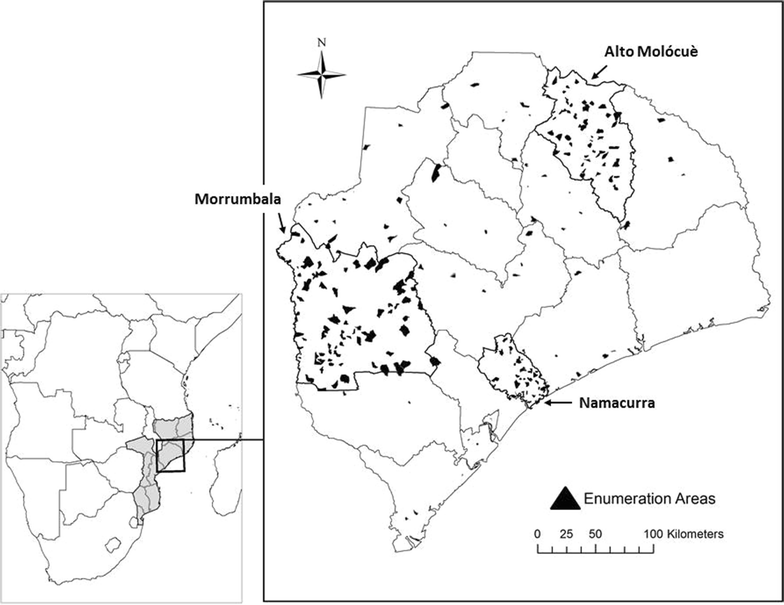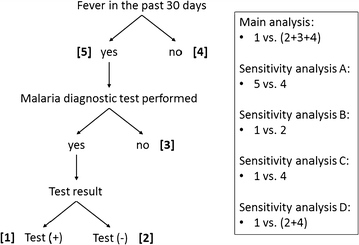Prevalence and determinants of malaria among children in Zambézia Province, Mozambique
- PMID: 28274257
- PMCID: PMC5343407
- DOI: 10.1186/s12936-017-1741-z
Prevalence and determinants of malaria among children in Zambézia Province, Mozambique
Abstract
Background: Malaria is the leading cause of death among children in Mozambique. Prevalence and factors associated with malaria are not well studied among children in rural Zambézia Province. Whether prevalence of malaria varies across diverse districts within the province is unknown.
Methods: A cross-sectional survey of female heads of household was conducted during April and May 2014, a period of peak malaria transmission. Data were collected on up to two randomly selected children aged 6-59 months per household. The outcome of interest was self-report of symptomatic malaria confirmed by diagnostic test in the past 30 days. Analyses accounted for the two-stage cluster sample design. Prevalence of symptomatic malaria was calculated for the province and three over-sampled focus districts-Alto Molócuè, Morrumbala, and Namacurra. Multivariable logistic regression of symptomatic malaria diagnosis included: district, age, sex, education, bed net use, urban setting, distance to health facility, income, roofing material, and pig farming.
Results: Data were collected on 2540 children. Fifty percent were female, and the median age was 24 months. Sixty percent of children slept under bed nets the night prior to the survey, but utilization varied between districts (range 49-89%; p < 0.001). Forty-three percent of children reported fever in the past 30 days, 91% of those sought care at a health facility, 67% of those had either a malaria rapid diagnostic test or blood smear, and 67% of those had a positive test result and therefore met our case definition of self-reported symptomatic malaria. There were significant differences in prevalence of fever (p < 0.001), health-seeking (p < 0.001), and diagnostic testing (p = 0.003) between focus districts. Province-wide prevalence of symptomatic malaria was 13% and among focus districts ranged from 14% in Morrumbala to 17% in Namacurra (p < 0.001). Higher female caregiver education (OR 1.88; 95% CI 1.31-2.70), having fewer young children in the household (OR 1.25; 95% CI 1.01-1.56), and higher income (OR 1.56; 95% CI 1.11-2.22) were independently associated with having a child with symptomatic malaria.
Conclusions: Self-reported symptomatic malaria is highly prevalent among children in Zambézia Province, Mozambique and varies significantly between diverse districts. Factors facilitating access to health services are associated with symptomatic malaria diagnosis. These findings should inform resource allocation in the fight against malaria in Mozambique.
Keywords: Child; Fever; Health services accessibility; Infant; Malaria; Mozambique; Prevalence; Risk factors.
Figures



Similar articles
-
Factors associated with the use of mosquito bed nets: results from two cross-sectional household surveys in Zambézia Province, Mozambique.Malar J. 2016 Apr 11;15:196. doi: 10.1186/s12936-016-1250-5. Malar J. 2016. PMID: 27068575 Free PMC article.
-
High prevalence of malaria in Zambezia, Mozambique: the protective effect of IRS versus increased risks due to pig-keeping and house construction.PLoS One. 2012;7(2):e31409. doi: 10.1371/journal.pone.0031409. Epub 2012 Feb 20. PLoS One. 2012. PMID: 22363640 Free PMC article.
-
Quality of malaria services offered in public health facilities in three provinces of Mozambique: a cross-sectional study.Malar J. 2019 May 6;18(1):162. doi: 10.1186/s12936-019-2796-9. Malar J. 2019. PMID: 31060605 Free PMC article.
-
Predictors of Health-Care Utilization Among Children 6-59 Months of Age in Zambézia Province, Mozambique.Am J Trop Med Hyg. 2017 Feb 8;96(2):493-500. doi: 10.4269/ajtmh.16-0233. Epub 2016 Nov 7. Am J Trop Med Hyg. 2017. PMID: 27821686 Free PMC article.
-
Assessing spatial patterns of HIV knowledge in rural Mozambique using geographic information systems.Trop Med Int Health. 2015 Mar;20(3):353-64. doi: 10.1111/tmi.12437. Epub 2014 Dec 15. Trop Med Int Health. 2015. PMID: 25430042
Cited by
-
Achieving malaria testing and treatment targets for children under five in Mozambique: a cost-effectiveness analysis.Malar J. 2022 Nov 7;21(1):320. doi: 10.1186/s12936-022-04354-9. Malar J. 2022. PMID: 36344998 Free PMC article.
-
The challenge of rapid management of fever in children under 5 in Guinea.Epidemiol Infect. 2018 Nov;146(15):1987-1995. doi: 10.1017/S0950268818002029. Epub 2018 Jul 26. Epidemiol Infect. 2018. PMID: 30047351 Free PMC article.
-
"We have this, with my husband, we live in harmony": exploring the gendered decision-making matrix for malaria prevention and treatment in Nampula Province, Mozambique.Malar J. 2020 Mar 30;19(1):133. doi: 10.1186/s12936-020-03198-5. Malar J. 2020. PMID: 32228613 Free PMC article.
-
Clinical malaria incidence and health seeking pattern in geographically heterogeneous landscape of western Kenya.BMC Infect Dis. 2022 Oct 3;22(1):768. doi: 10.1186/s12879-022-07757-w. BMC Infect Dis. 2022. PMID: 36192672 Free PMC article.
-
Risk factors associated with malaria infection identified through reactive case detection in Zanzibar, 2012-2019.Malar J. 2021 Dec 24;20(1):485. doi: 10.1186/s12936-021-04025-1. Malar J. 2021. PMID: 34952596 Free PMC article.
References
-
- WHO. World malaria report 2015. Geneva: World Health Organization; 2015. http://apps.who.int/iris/bitstream/10665/200018/1/9789241565158_eng.pdf?.... Accessed 10 Oct 2016.
-
- Mozambique National Institute of Statistics, U.S. Census Bureau, MEASURE Evaluation, U.S. Centers for Disease Control and Prevention. Mortality in Mozambique: results from a 2007–2008 post-census mortality survey. http://www.cpc.unc.edu/measure/resources/publications/tr-11-83/. Accessed 10 Oct 2016.
-
- Harris I, Jones PD, Osborn TJ, Lister DH. Updated high-resolution grids of monthly climatic observations—the CRU TS3.10 dataset. Int J Climatol. 2014;34:623–642. doi: 10.1002/joc.3711. - DOI
MeSH terms
Grants and funding
LinkOut - more resources
Full Text Sources
Other Literature Sources
Medical
Miscellaneous

